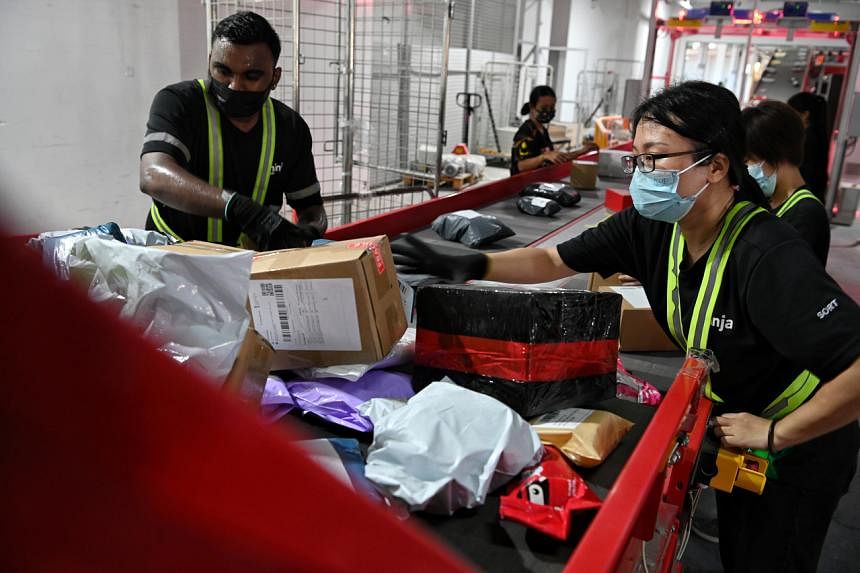SINGAPORE – Ms Caitlyn Cheng, who has been shopping one-commerce platform Taobao for about eight years, became more selective in her purchases after noticing a rise in shipping costs at the start of the year.
“I am paying about 30 to 40 per cent more for shipping as a whole,” said the 27-year-old technology analyst, whose purchases include clothes, household items and fashion accessories from China.
She opts for sea freight as it is cheaperthan air freight, with the cost based on weight.
“I would definitely think twice now before purchasing any goods, especially expensive or bulky items,” she added.
Earlier this month, freight forwarder vPost announced it was suspending its China sea freight service and all shipping services from Indonesia to Singapore from Aug 24 due to high freight costs.
Singapore Post, which runs vPost, said it tried to make shipping more affordable for its customers earlier this year, such as having discounts for bundling multiple parcels. But it said freight costs remain high, even after it introduced in July a fuel surcharge that customers must pay.
“Therefore, we have taken the difficult decision to suspend these services instead of passing the higher costs on to the customers,” said a SingPost spokesman. “The suspended services are also among those with the lowest demand across our network, so impact to customers is minimal.”
Mr Bernard Chan, director of freight forwarding service Penanshin Air Express, said shipping rates rose exponentially during the Covid-19 pandemic.
For instance, the cost of shipping a 20ft container to Los Angeles by sea in 2021 shot up to about 10 times that of 2019. It is now four times of pre-Covid-19 rate.
Similarly, Penanshin’s rate for shipping a 20ft container to Shanghai in 2021 increased to about 15 times of 2019’s rate. It is now about five times of the pre-Covid-19 rate.
Mr Bala Thangavalu, sales manager of freight forwarding company The National Forwarder, said the air freight to Colombo in July was about three times of the pre-Covid-19 rate.
The company’s freight costs often fluctuate. At the start of this year, freight costs to major airports in China such as Shanghai and Qingdao were about twice the amount of pre-Covid-19 prices. Currently, they stand at about 21/2 times of pre-Covid-19 prices.
Mr Thangavalu added that the company would still have to mark up these prices to cover its operational costs and turn a profit.
Associate Professor Goh Puay Guan of the National University of Singapore Business School said higher freight rates can be attributed to demand outstripping supply.
“While consumer and business demand shot up as countries started on economic recovery from 2021, there were shipping bottlenecks and manufacturing disruptions on the supply side,” he said.
The bottlenecks were caused by various factors, including lockdowns, safe distancing measures in shipping ports and workers falling ill, Prof Goh added.
Higher fuel and labour costs have also pushed up prices, said Mr Divay Goel, chief investment officer of Prudent Shipping Investments, which advises financial institutions on shipping and port investments.
Some consumers are still willing to pay the higher air and sea freight rates.
“Purchasing items from overseas is still relatively cheaper than getting the items locally,” said Ms Michelle Ng, who has been shopping at Taobao once every two months for almost a decade. Her purchases include fashion products and furniture for her new Build-To-Order flat.
The 32-year-old business manager now pays $1 to $1.50 extra per kg at Taobao for air shipments and about $10 extra for each cubic metre for sea shipments, compared with pre-Covid-19 rates.
Consumers here may get a respite from high freight charges in the next few months, with experts expecting an improvement in the global supply chain situation.
Prof Goh said: “Bottlenecks in supply chains are starting to ease, while shipping and manufacturing capacities are gradually catching up to demand.”
Associate Professor Yap Wei Yim, the head of Singapore University of Social Sciences’ (SUSS) maritime management minor programme, said shipping lines are also expected to manage capacity better after tackling challenges of freight demand and disruptions to the global supply chain caused by the pandemic.
However, a return to pre-Covid-19 levels is unlikely to happen soon, with Prudent Shipping Investments’ Mr Goel expecting the stabilised rates to still be at least 10 per cent higher than pre-pandemic rates.


